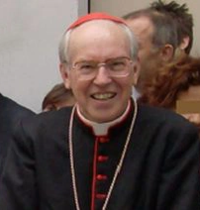
The dean of the College of Cardinals (Latin: Decanus Collegii Sanctae Romanae Ecclesiae Cardinalium) presides over the College of Cardinals in the Catholic Church, serving as primus inter pares (first among equals). The position was established in the 12th century.[citation needed] He always holds the rank of a cardinal bishop, and is assisted by a vice-dean. Both are elected by and from the cardinal bishops who are not Eastern Catholic patriarchs, with their election subject to papal confirmation. Except for presiding over the college, the dean and vice-dean have no power over the other cardinals. In the order of precedence in the Catholic Church, the dean and vice-dean, as the two most senior cardinals, are placed second and third, respectively, after the pope.
For centuries, the cardinal bishop who had been a bishop of a suburbicarian see the longest was the dean. This custom became a requirement with the canon law of 1917.[1][2][a] On 26 February 1965, Pope Paul VI empowered the cardinal bishops to elect the dean from among their number.[3][b] Both the dean and subdean must reside in Rome.[1]
Until December 2019, the dean held the position until death or resignation; there was no mandatory age of retirement.[4] Then, upon accepting Cardinal Angelo Sodano's resignation as dean of the College of Cardinals, Pope Francis established that the dean would henceforth serve a five-year term that may be renewed once.[5][6] In anticipation of the election of a new dean, Francis said: "I am hoping they will elect someone who can carry this important responsibility full time."[7]
- ^ a b Coriden, James A.; Beal, John P.; Green, Thomas Joseph, eds. (2000). New Commentary on the Code of Canon Law. Paulist Press. p. 470. ISBN 978-0-8091-4066-4. Retrieved 2 January 2024.
Paul VI changed the former provision whereby the dean was automatically the cardinal who had been cardinal bishop the longest.
- ^ a b Acta Apostolicae Sedis (PDF) (in Latin). Vol. IX, part II. 1917. p. 50, Canon 237. Retrieved 22 December 2019.
- ^ "Sacro Cardinalium Consilio: Elezione del Decano e del Subdecano del Collegio Cardinalizio" (in Italian). Libreria Editrice Vaticana. 26 February 1965. Retrieved 2 January 2024.
- ^ Wooden, Cindy (22 December 2019). "Pope sets term of office for dean of College of Cardinals". ncronline.com. The National Catholic Reporter Publishing Company. Retrieved 20 September 2020.
- ^ "A Letter in the form of a "Motu Proprio" regarding the Office of Dean of the College of Cardinals, 21.12.2019". 29 November 2019. Retrieved 21 December 2019.
- ^ Senèze, Nicolas (21 December 2019). "Démission d'Angelo Sodano, doyen des cardinaux". La Croix (in French). Retrieved 22 December 2019.
- ^ "Audience of the Holy Father to the Roman Curia on the occasion of the presentation of Christmas wishes, 21.12.2019". Holy See Press Office. 21 December 2019. Retrieved 21 December 2019.
Cite error: There are <ref group=lower-alpha> tags or {{efn}} templates on this page, but the references will not show without a {{reflist|group=lower-alpha}} template or {{notelist}} template (see the help page).